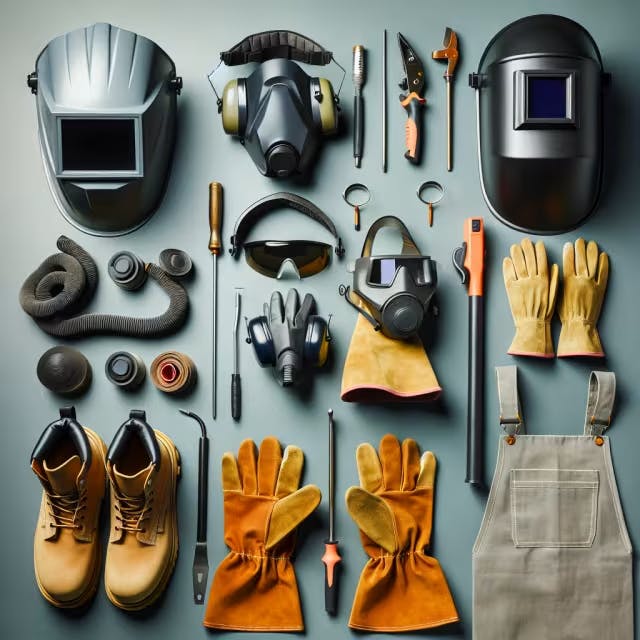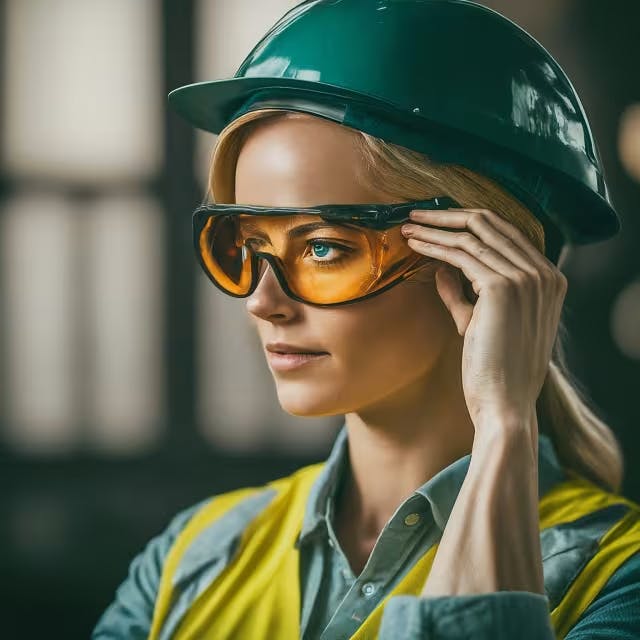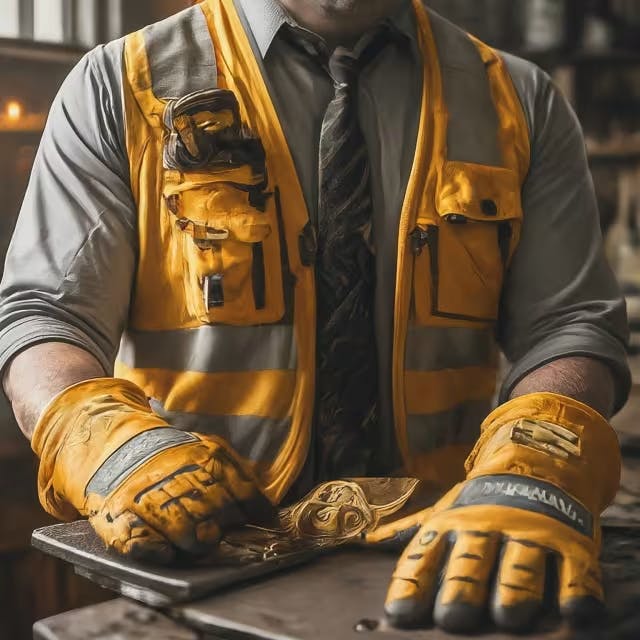Essential Protective Gear for Metalwork Safety
Abana Chapter
February 11, 2024

Navigating the intricate world of metalwork requires more than just skill and precision; it demands a thorough understanding of the essential protective gear necessary for ensuring safety. With Personal Protective Equipment (PPE) recognized as a crucial barrier against the multitude of hazards present in this industry, from sharp edges to flying debris, equipping oneself with the right safety attire becomes paramount. Whether you're a seasoned professional or a newcomer to the field, this article delves into the critical aspects of metalwork safety gear, offering insights on how to protect your eyes, hands, feet, and hearing, thereby minimizing the risk of injury during metalwork operations.
Key Takeaways
Personal Protective Equipment (PPE) is essential in the metalwork industry to serve as a barrier against hazards such as sharp edges and flying debris.
The proper selection and use of safety glasses are critical for eye protection against particles and sparks generated during metalworking processes.
Heavy-duty gloves are indispensable to safeguard hands from cuts, burns, and other injuries commonly encountered in metalwork.
Protective footwear is vital to prevent foot injuries from falling objects and sharp materials commonly found in metalworking environments.
Hearing protection is necessary to mitigate the risk of noise-induced hearing loss from the constant exposure to loud noise levels during metalwork operations.
Understanding the importance of proper gear is fundamental in minimizing the risk of injury in the metalwork industry.
Understanding Metalwork Safety: The Importance of Proper Gear
Safety in metalwork is paramount, and outfitting oneself with the right protection can greatly reduce the risk of injuries. Personal Protective Equipment (PPE) forms a critical barrier against potential hazards present in the metalworking environment.
Protective Clothing: Essential to guard against burns from hot metal or sparks. Durable materials like leather offer the best protection.
Safety Goggles and Face Shields: Protect the eyes from harmful debris and bright flashes, especially during welding, cutting, or grinding operations.
Respirators and Masks: Necessary to prevent inhalation of harmful fumes or dust.
Gloves: Leather gloves are preferred for their ability to resist cuts and burns. For welding tasks, longer gloves that cover a portion of the arm provide added protection.
Helmets: Critical for welding tasks, helmets protect the face, neck, and eyes from UV radiation, sparks, and hot debris.
Boots: Steel-toed boots protect feet from heavy falling objects and sharp items on the ground.
According to SafetyCulture, ensuring the proper use, maintenance, and disposal of PPE is vital for its effectiveness. Likewise, Metal Exponents emphasizes the importance of machine safeguards and regular maintenance of equipment, in addition to PPE, to mitigate the risks inherent in metalwork. They also suggest keeping workplaces organized and having a first aid kit ready as preventive measures.
By conducting hazard assessments and providing comprehensive PPE training, businesses can significantly bolster workplace safety and productivity. This approach to safeguarding workers highlights the commitment of industry leaders to uphold high standards of safety and efficiency.

Essential Eye Protection: Choosing the Right Safety Glasses
Selecting the right safety glasses is a critical decision in ensuring metalwork safety. With over 2,000 workers experiencing eye injuries daily, it's clear how pivotal proper eye protection is. Options range from full-frame glasses to frameless ones and even goggles, each designed to cater to specific hazards and environments. Here's a quick guide to help identify the most suitable type:
Full-Frame Glasses: Offer robust protection against projectiles and debris. They are ideal for high-impact environments.
Frameless Glasses: Provide a lightweight option with less obstruction to the field of vision, suitable for tasks requiring precision.
Goggles: Best for environments where chemical splashes or dust is a concern, offering a seal around the eyes.
Innovations like SOL-X are paving the way for advancements in personal protective equipment, integrating digital technology to preempt accidents and ensure compliance. This tech-forward approach underscores the importance of not just wearing PPE, but choosing the most effective type for the job at hand.
For more detailed insights into selecting the right safety eyewear and how technology is transforming PPE, visit Choosing the Right Safety Eyewear.

Heavy-Duty Gloves: Your First Defense Against Metalwork Injuries
Selecting the right protective gear, especially heavy-duty gloves, is a crucial decision in metalwork safety. Eagle, leading in safety innovation, offers gloves that stand out in quality and cleanliness. Their unique Delta Zero™ testing program guarantees gloves are free from harmful contaminants, making them a safe choice for metalworkers. Eagle's gloves not only protect users but also ensure a clean working environment, essential in metalwork projects. With options designed for durability, comfort, and performance, these gloves provide a significant level of protection. For more detailed information on their advanced glove technology, visit Eagle's website.
The Role of Protective Footwear in Metalwork
Choosing the right protective footwear is a critical aspect of ensuring safety in the metalwork industry. A study involving 509 metal-working factory workers highlighted common issues faced due to safety footwear (SFW), including skin lesions resulting from hot/wet conditions inside the SFW (42%), the weight of the shoes (27.5%), improper fit (22.9%), narrowness (19%), and poor sole flexibility (16.3%). These findings underscore the importance of selecting SFW that not only meets safety standards but also offers comfort and ergonomics. For more detailed insights into this study, read here.
Key Considerations for Selecting SFW
Comfort and Fit: Ensure that the footwear does not cause discomfort or restrict movement. A proper fit is crucial to prevent foot issues.
Breathability: Opt for materials that allow adequate air flow to minimize hot and wet conditions inside the shoe.
Weight: Lighter footwear reduces the strain on the feet over long periods of use.
Sole Flexibility: Flexibility in the sole helps in maintaining a natural foot movement.
By prioritizing these features when choosing safety footwear, workers can significantly reduce the risk of foot problems and enhance their overall safety in metalwork operations.
The Significance of Hearing Protection During Metalwork Operations
Metalwork involves exposure to high levels of noise, which can pose significant risks to hearing health. Prolonged exposure to these noise levels can lead to permanent hearing loss, emphasizing the need for proper hearing protection. Employing earplugs or earmuffs is a simple yet effective way to safeguard against these risks. Each type of hearing protection offers distinct advantages, tailored to different metalwork environments.
Earplugs: These are ideal for environments where noise levels are high but not excessively so. They're lightweight, easily portable, and can fit snugly inside the ear canal, offering a level of noise reduction suitable for many metalwork scenarios.
Earmuffs: For situations where noise levels are exceedingly high, earmuffs provide superior protection. They cover the entire ear, ensuring a comprehensive barrier against noise.
Selecting the right type of hearing protection is crucial, as it directly impacts the wearer's safety and comfort. A good practice is to check the Noise Reduction Rating (NRR) of the protection device, ensuring it matches the specific requirements of the metalwork task at hand.
Remember, integrating hearing protection into your safety gear is not just about adhering to safety regulations; it's about ensuring long-term hearing health, enabling metalworkers to continue their craftsmanship without compromising their wellbeing. For a detailed guide on selecting the appropriate hearing protection for metalwork, consider exploring resources provided by occupational safety and health organizations. In conclusion, embracing the essential protective gear for metalwork safety is not just a regulatory requirement but a crucial step towards ensuring the well-being of those involved in metalworking operations. With advancements in personal protective equipment, like SOL-X and Eagle's Delta Zero™ testing program for gloves, along with the emphasis on the proper selection, use, and maintenance of PPE, metalworkers are better protected than ever before. By prioritizing eye protection, heavy-duty gloves, protective footwear, and hearing protection, we can significantly mitigate the risks associated with metalwork and foster a safer working environment for all.
Frequently Asked Questions
What are the essential pieces of protective gear needed for metalwork safety?
Essential protective gear for metalwork safety includes durable protective clothing, safety goggles and face shields for eye protection during welding, cutting, or grinding operations, and respirators or masks to prevent inhalation of harmful fumes or dust. Leather gloves are preferred for their resistance to cuts and burns, with longer gloves providing added arm protection during welding tasks. Helmets are critical for face, neck, and eye protection from UV radiation, sparks, and heat during welding. Steel-toed boots protect feet from heavy objects and sharp hazards on the ground. Regular equipment maintenance, workplace organization, and proper PPE use training are crucial for mitigating risks in metalwork environments.
How do safety goggles and face shields protect metalworkers?
Safety goggles and face shields form an integral part of personal protective equipment (PPE) for metalworkers, safeguarding them against a variety of hazards encountered in their work environment. These protective gear pieces are specifically designed to shield the eyes and face from harmful debris, flying sparks, and bright flashes that occur during welding, cutting, or grinding operations. The effectiveness of safety goggles and face shields in preventing injuries hinges on their ability to provide a clear barrier against physical threats, while also offering features like UV protection during welding tasks. This dual-functionality not only enhances the safety and productivity of metalworkers but also ensures compliance with industry safety standards, significantly reducing the risk of eye injuries and long-term vision damage.
Why are leather gloves recommended over other materials for metalwork?
Leather gloves are recommended for metalwork due to their superior durability and protection. Leather naturally resists cuts, abrasions, and burns, making it an ideal material to protect hands from the sharp edges and high temperatures commonly encountered in metalworking tasks. Moreover, for welding and similar tasks, leather gloves can be longer, covering a portion of the arm to provide added protection against sparks and splatters. This makes leather gloves a critical component of personal protective equipment in the metalwork industry, ensuring both safety and efficiency.
What criteria should be considered when selecting the right safety footwear for metalwork?
When selecting safety footwear for metalwork, several critical criteria must be considered to ensure both protection and comfort:
Comfort and Fit: The footwear should be snug yet comfortable, allowing for free movement without constriction or pressure points.
Breathability: Choose materials that allow good airflow to prevent moisture buildup, which can lead to discomfort and skin issues.
Weight: Lightweight shoes reduce fatigue over long periods of work, making them preferable for daily use in metalworking environments.
Sole Flexibility: The sole's flexibility is important for maintaining natural foot movement, crucial for tasks that involve standing or moving for extended periods.
Protection Features: Look for steel-toed boots or other materials that can protect feet from falling objects, sharp items, and high temperatures common in metalwork settings.
Selecting the right safety footwear not only contributes to reducing the risk of injuries but also enhances worker comfort, leading to improved productivity and job satisfaction in the metalworking industry.
How can modern technology contribute to the effectiveness of protective gear in metalwork?
Modern technology greatly enhances the effectiveness of protective gear in metalwork by introducing advanced materials and design features. Durable materials like leather for gloves and clothing provide superior protection against cuts and burns. Innovations such as the integration of digital technology in PPE, like SOL-X, help in pre-empting accidents and ensuring compliance with safety standards. Additionally, advancements in protective footwear focus on comfort, breathability, and ergonomic design to prevent foot problems, making safety footwear (SFW) more effective for long-term wear in metalworking environments. The emphasis on selecting the right type of PPE, based on comprehensive hazard assessments and tailored to specific tasks, ensures that workers are not only protected but also comfortable, thereby enhancing productivity and safety in metalwork.
What is the significance of choosing the right type of hearing protection in metalwork safety?
Choosing the right hearing protection in metalwork is vital to safeguard against the substantial risk of permanent hearing loss due to prolonged exposure to high noise levels. Earplugs and earmuffs are primary protective devices, each suitable for different noise environments. Earplugs are best for high but not excessive noise, fitting snugly in the ear canal and offering portability, while earmuffs provide superior protection in extremely loud conditions by covering the entire ear. Checking the Noise Reduction Rating (NRR) of the device is essential to ensure it meets the specific requirements of the metalwork task. Proper hearing protection is a crucial step in preserving long-term hearing health, allowing metalworkers to continue their work without compromising their well-being.


